 |
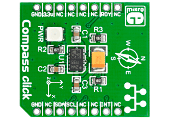
|
|
Compass Click is an add-on board in the mikroBUS form factor. It features the LSM303DLHC ultra-compact high-performance e-compass 3-axis magnetometer and 3-axis accelerometer module. It includes a specific sensing element and an IC interface capable of measuring both linear acceleration (full-scale of ±2g/±4g/±8g/±16g) and magnetic field (from ±1.3 to ±8.1 gauss full-scale), both in 3 dimensions, and provides a 16-bit data output through an I2C interface. By combining both a compass and an accelerometer in the same chip, magnetic north can be determined regardless of unit orientation. Readings received from the IC can be processed and used to determine earth's magnetic north pole. The board is designed to use a 3.3V power supply only. All these features make this board ideal for compensated compass, position detection, map rotation, pedometer, display orientation and many more applications. |
|
|
|
 |
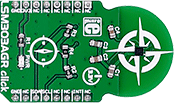
|
|
LSM303AGR click measures acceleration and magnetic field characteristics. It carries the LSM303AGR 3D accelerometer and 3D magnetometer.
LSM303AGR click is designed to run on a 3.3V power supply. It communicates with the target microcontroller over I2C interface, with additional functionality provided by the INT pin on the mikroBUS™ line. |
|
|
|
 |

|
|
Compass 2 click is a mikroBUS add-on board with an AK8963 3-axis electronic compass. The high sensitivity sensor is based on the Hall effect. The built-in ADC converter can be set up at either 14 or 16 bit resolution, for each of the 3 axes. The sensitivity is 0.6µT /LSB typ. at 14-bit, and 0.15µT/LSB at 16-bit. Compass 2 click communicates with the target MCU through either through the I2C or SPI interface, with an added INT pin. Onboard jumpers enable you to switch between two interfaces. The board is designed to use a 3.3 power supply only. |
|
|
|
 |
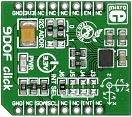
|
|
9DOF click carries ST's LSM9DS1 inertial measurement module that combines a 3D accelerometer, a 3D gyroscope and a 3D magnetometer into a single device outputting so called nine degrees of freedom data (3-axis acceleration, angular velocity and heading), in 16-bit resolution. 9DOF click communicates with the target MCU through the mikroBUS I2C interface (SCL and SDA) with additional functionality provided by the programmable Interrupt (INT) pin, as well as the Enable (EN) pin. The IC has multiple interrupt lines which can be accessed through jumpers on the click board. I2C addresses are specified in the same manner. The board uses a 3.3 power supply only. |
|
|
|
 |
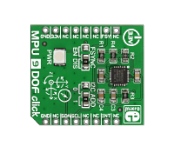
|
|
MPU 9DOF click carries the MPU-9150 System in Package, which is the world's first 9-axis Motion Tracking device. MPU-9150 comprises two chips. One is the MPU-6050 that contains a 3-axis accelerometer, a 3-axis gyroscope, and a DMP (digital motion processor); the other is AK8975, a 3-axis digital compass. The MPU-9150 is designed for the low power, low cost, and high performance requirements of consumer electronics equipment and wearable sensors. The ability to track motion in free space also makes MPU 9DOF click a suitable sensor for RC vehicle (e.g. quadcopters) and camera stabilisation systems. |
|
|
|
 |
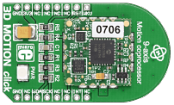
|
|
3D Motion click carries Microchip’s MM7150 9-axis sensor fusion motion module. It's a complete self contained solution comprising a 3-axis accelerometer, a gyroscope, a magnetometer, and a SSC7150 motion coprocessor. The motion coprocessor has sensor fusion alghoritms that take raw data from individual sensors and filter, compensate and combine them together. The resulting output provides reliable and accurate positioning and orientation information. The board communicates with the target MCU through the mikroBUS I2C interface; WAKE and RESET pins are also used (in placed of default mikroBUS AN and RST respectively), as well as an interrupt pin (INT). |
|
|
|
 |
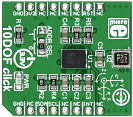
|
|
10DOF click is a mikroBUS add-on board for enhancing hardware prototypes with 10DOF functionality (10 degrees of freedom). The click board carries two modules from Bosch: BNO055, a 9-axis absolute orientation sensor and BMP180, a digital pressure sensor. The BNO055 contains 3 sensors: a 3-axis 16-bit gyroscope, a 14-bit 3-axis accelerometer, and a 3-axis magnetometer, as well as a 32-bit ARM Cortex-M0 MCU with Bosch Sensortec sensor fusion algorithms. The pressure sensor is based on piezo-resistive technology, enabling high accuracy, linearity and long term stability. 10DOF click communicates with the target board MCU through the mikroBUS I2C interface (SCL, SDA), with additional functionality provided by INT and RST pins. Designed to use a 3.3V power supply only. |
|
|
|
 |
|

